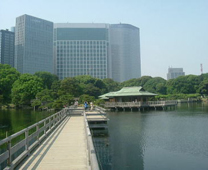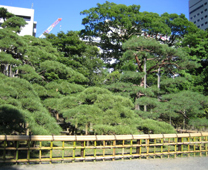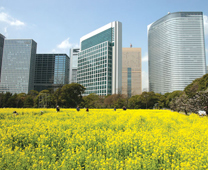
Travel Guide
Introduction
Hamarikyu Gardens is Tokyo’s most attractive and historic landscape garden and is a designated Special Place of Scenic Beauty. What was originally the garden of a feudal lord’s residence from the Edo Period (1603-1867), is now a hotspot for both tourists and residents alike.
Located alongside Tokyo Bay, Hamarikyu Gardens features seawater ponds which change level with the tides, cherry blossom in spring time and autumn leaves in mid November, and a teahouse on an island where visitors can rest and enjoy the scenery. It has a pleasant atmosphere of tranquility which allows you to relax and just enjoy the wonderful scenery.
The garden is planted with a range of flowers, trees and shrubs so that there is a burst of color in every season. In the garden there is a plum grove, a 300 year old pine tree, a tree peony garden, a garden of flowering trees and shrubs, hillocks, bridges, duck hunting sites, horse riding areas, yellow rapeseed fields, and some of the river cruise boats dock inside the garden grounds.
Although not as famous for its fall foliage as some of the other gardens around Tokyo, it offers plenty of maple, ginkgo and other trees that show their beautiful autumn colors between late November and early December.
Late February brings plum blossoms, while the spring cherry blossom season from late March to early April is also nice but somewhat subdued compared to other hanami spots in the city. Several other species of flowers bloom in spring including fields of peony and canola blossoms.
Visitors can also enjoy refreshment at a teahouse in Nakashima located in the middle of the pond in the garden that offers matcha and Japanese sweets in a tea-ceremony style. A peony garden, plum tree grove and cosmos fields have flowers for every season. Japanese falconry and aikido are demonstrated at New Year.
Overlooking the tranquil and picturesque garden are the shiny skyscrapers of the Shiodome business area, this creates a contrast between nature and man-made structures.
History
The site of the garden was originally a tidal duck hunting ground. In 1654, Matsudaira Tsunashige, feudal lord of the Kofu domain, reclaimed part of the tidal ponds to build an urban family villa. The ponds were elaborated on and continued to be used for duck hunting (with nets). They are now a sanctuary within Tokyo for a number of wild species of birds and fish.
The founder Tsunashige's son, Ienobu, later became the 6th Shogun of Japan, and the property became that of the ruling Tokugawa family. The Tokugawa elite could access the garden by boat and remains of a landing stage is still visible at Shogun O-agariba not far from the present day water bus stop.
Shogun Ienobu later renovated the gardens and renamed them renamed "Hama Goden" (Beach Palace). Successive Shoguns made a number of innovations, and the gardens reached their final form under the eleventh Shogun, Ienari.
As with Kyu-Shiba Rikyu Gardens, the property passed to the Imperial Family after the Meiji Restoration of 1868. It was then that it became the Hamarikyu Onshi Teien, or Hama Detached Palace. It was badly damaged by the Great Kanto Earthquake of 1923 and then in the Second World War, and was finally taken over by Tokyo city and opened to the public in 1946. It was officially named a site of great cultural and historical value, in 1952.
 |
 |
 |
| Bridge, pond and tea house | 300 year old pine tree | Yellow rapeseed fields |
Travel Advice
Toor Guide
- Free regular Japanese toor guide is available at the following times: 11:00 and 14:00 on Saturdays and national holidays except August.
- Free English toor guide at 11:00 every Saturday except August.
Events
| Events in 2020 | ||
| New Year event | There will be spectacular hawk presentations and shows, traditional tea ceremonies, and traditional Japanese New Year toy experience. Visitors also can enjoy seasonal flowers and a serene, relaxing atmosphere. | Jau 2(Thu) and 3 (Fri) |
Visit
| Address | 1-1 Hamarikyuteien, Chuo-ku, Tokyo | |
| Phone | 03-3541-0200 | |
| Admission | Senior: 150 yen (Groups 120 yen) Adult: 300 yen (Groups 240 yen) |
Senior: over 65 Adult: over 12 Groups: over 20 May 4 and October 1 are free |
| Hours | 09:00 to 17:00 | Entry until 30 minntes before closing |
| Closed | December 29 to January 1 | |
| Duration | 30 minutes | |
| Getting There | By Train 7 minutes walk from Chukizishijo Station or Shiodome Station on subway Oedo Line. 7 minutes walk from Shiodome Station on Yurikagome Line. 12 minutes walk from Shinbashi Station on JR Lines, subway Ginza Line or subway Asakusa Line. 1 minute walk from Hamarikyu stop on Sumida River Cruise. By Car Take Shuto Expressway to the Shiodome exit. It is approximately 1 minute from exit. |
|
| Parking | No parking available | |

